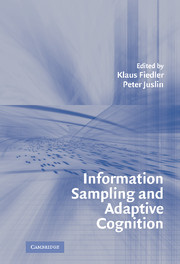Book contents
- Frontmatter
- Contents
- List of Contributors
- PART I INTRODUCTION
- PART II THE PSYCHOLOGICAL LAW OF LARGE NUMBERS
- PART III BIASED AND UNBIASED JUDGMENTS FROM BIASED SAMPLES
- PART IV WHAT INFORMATION CONTENTS ARE SAMPLED?
- PART V VICISSITUDES OF SAMPLING IN THE RESEARCHER'S MIND AND METHOD
- 16 Which World Should Be Represented in Representative Design?
- 17 “I'm m/n Confident That I'm Correct”: Confidence in Foresight and Hindsight as a Sampling Probability
- 18 Natural Sampling of Stimuli in (Artificial) Grammar Learning
- 19 Is Confidence in Decisions Related to Feedback? Evidence from Random Samples of Real-World Behavior
- Index
- References
16 - Which World Should Be Represented in Representative Design?
Published online by Cambridge University Press: 02 February 2010
- Frontmatter
- Contents
- List of Contributors
- PART I INTRODUCTION
- PART II THE PSYCHOLOGICAL LAW OF LARGE NUMBERS
- PART III BIASED AND UNBIASED JUDGMENTS FROM BIASED SAMPLES
- PART IV WHAT INFORMATION CONTENTS ARE SAMPLED?
- PART V VICISSITUDES OF SAMPLING IN THE RESEARCHER'S MIND AND METHOD
- 16 Which World Should Be Represented in Representative Design?
- 17 “I'm m/n Confident That I'm Correct”: Confidence in Foresight and Hindsight as a Sampling Probability
- 18 Natural Sampling of Stimuli in (Artificial) Grammar Learning
- 19 Is Confidence in Decisions Related to Feedback? Evidence from Random Samples of Real-World Behavior
- Index
- References
Summary
University of California, Berkeley campus, early 1940s. A man and a young woman are strolling across the university campus. Suddenly the man stops and says, “Now.” The woman also stops, raises her arm, points to the building in front of her, and says, “The window on the second floor.” After contemplating the scene for a moment, she says “Three-and-a-half feet.” The man records this and other numbers. They begin walking again. A few moments later, the man stops once again and the same interaction repeats itself.
University of Constance, vision laboratory, mid-1980s. A young man enters a dark room. The experimenter welcomes him and then asks him to sit down in front of a large cubicle, to put his chin on a rest (thus making it impossible to move his head), and to look into the cubicle through two small holes. Its interior is completely dark. Suddenly a white square appears, only to disappear a few seconds later. Then, a tone is heard, which is followed by another white square to the right of the previous one. The young man says, “The left one.” This episode frequently repeats itself over the course of the next half hour.
Although both scenes represent the same genre, namely, psychological studies on the perception of object size, they share few common features. As we shall see shortly, their differences can be traced back to the fact that the Berkeley study was conceived by Egon Brunswik (1944; for a replication, see Dukes, 1951), whereas a contemporary experimental psychologist conducted the Constance study.
- Type
- Chapter
- Information
- Information Sampling and Adaptive Cognition , pp. 381 - 408Publisher: Cambridge University PressPrint publication year: 2005

